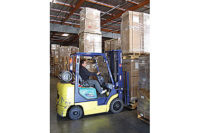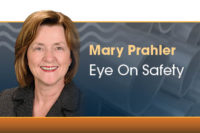
|
According to the National Oceanic and Atmospheric Administration, heat is the No. 1 weather-related killer in the United States. It is the responsibility of every employer to ensure employees are kept safe during high heat conditions.
Extreme caution must be taken when the heat index exceeds 90° F. The heat index is a measure of how hot it feels when relative humidity is added to the actual air temperature. A temperature of 90° F with 10% humidity will result in a heat index of 85° F, but with 60% humidity the heat index soars to 100° F.
When blood is heated above 98.6° F, our bodies dissipate heat by varying the rate and depth of blood circulation, by sweating, and as a last resort by panting. Sweating cools the body through evaporation. However, high relative humidity retards evaporation, robbing the body of its ability to cool itself. When heat gain exceeds the level the body can remove, body temperature begins to rise, and heat-related illnesses and disorders may develop.
NOAA devised the heat index values for shaded conditions and light winds. Full sunshine can increase heat index values by up to 15° F. Strenuous work and the use of heavy or specialized protective clothing also have an added effect. As a result, the risk at a specific heat index could be higher if the work is performed in direct sunlight without a light breeze, involves strenuous tasks or involves the use of heavy protective clothing.
OSHA has developed a free mobile app that calculates heat indexes for where you are located. There is a “More Information” button where you can find signs and symptoms of heat-related illnesses, first-aid measures and details about steps to reduce the risk of developing a heat-related illness. It is available through your smartphone or at www.osha.gov/OshStd_toc/OSHA_Std_toc.html.
OSHA’s emphasis this year is on the need for employers to acclimatize workers. “Acclimatization is a physical change that the body undergoes to build tolerance to heat, and it is a critical part of preventing heat illnesses and fatalities,” said Dr. David Michaels, assistant secretary of labor for occupational safety and health. “Over the past three years, lack of acclimatization was the cause in 74% of heat-related citations issued. Employers have a responsibility to provide workplaces that are safe from recognized hazards, including outdoor heat.”
To acclimatize, workers should get used to hot environments by gradually increasing exposure to the heat, take frequent breaks for water and rest in the shade. During a rapid change in excessively hot weather, even experienced workers need time to acclimatize.
Prevention of heat-related ailments is preferred over treatment once problems have developed. OSHA has initiated a campaign to prevent heat illnesses. The campaign is based upon three simple words: water, rest andshade.
The principals of this campaign can be applied to any worker who works in hot weather or in a space that is not air conditioned. Above all, it is critical for managers to monitor the heat index and respond to that information. Supervisors and employees need to be educated how to best manage high-heat situations and how to recognize the symptoms of and treatment for heat-related ailments.
OSHA also has numerous resources available for you at www.osha.gov/SLTC/heatillness/index.html.




